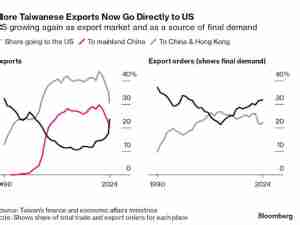China’s exports and imports struggled in April as worsening Covid outbreaks cut demand, undermined production and disrupted logistics in the world’s second-largest economy.
Export growth in April in dollar terms slowed to 3.9% from a year earlier, compared to an increase in March of 14.7%, customs data showed Monday. That’s the weakest pace since June 2020 but faster than the median estimate of a 2.7% gain in a Bloomberg survey of economists.
Imports were unchanged in April after sliding 0.1% in the previous month. Economists expected a 3% decline.
April’s data captures the impact of Covid restrictions on the trade and manufacturing hub Shanghai—home to the world’s largest port—where most of the population have been under some form of lockdown for more than five weeks. The disruptions add another threat to global supply chains and inflation, and have affected the operations of companies from Tesla Inc. to Apple Inc.
Zhang Zhiwei, president and chief economist at Pinpoint Asset Management said export growth may continue to be weak in May because of disruptions to supply chains.
“One big macro issue is to what extent export orders will be shifted to other emerging countries such as India and Vietnam,” he said.
What Bloomberg Economics Says
China’s April trade data offered a glimpse of how lockdowns in Shanghai and other parts of the country are affecting the world’s goods markets. It doesn’t look pretty. An abrupt slowdown in export growth underlines strain on global supply chains from the disruptions to factory output and logistics. Zero import growth—down from double digits just two months earlier—suggests domestic demand is cratering.
Eric Zhu, China economist
\China’s government is trying to get production back on track, but with many foreign businesses saying they’re still unable to resume operations and lockdowns tightening again, it’s unclear how much of the city is actually back to work.
The slowdown in trade is a concern as exports have been one of the strongest growth drivers for China, helping propel the economy out of its Covid-related slump in 2020 to a better-than-expected performance in 2021.
Inflation Effects
Imports were boosted by the soaring prices of energy and commodities. The value of coal imports rose almost 80% in the first four months of the year, while the volume of inbound shipments dropped 16%. The value of crude oil, natural gas, and steel also rose, while volumes fell.
Imports from Russia jumped almost 57%, likely boosted by rising prices of oil, gas and other commodities, which make up the majority of what China buys from Russia. The biggest declines in exports in April were to Russia, with shipments falling about 26% from a year ago, followed by Hong Kong, U.K., Japan and Germany. Exports to the U.S. rose 9.4%.
The slump in China’s trade came despite signs showing global demand likely stayed resilient last month. While South Korea’s exports—a leading indicator of world trade—grew by double digits in April, its shipments to China fell 3.4%.
Other data from April also showed the extent to which Covid-related disruptions have bruised the economy. Manufacturing activity plunged to its worst level since February 2020, while logistics bottlenecks have continued to be a strain. Suppliers face the longest delays in more than two years in delivering raw materials to their manufacturing customers and Chinese port activity fell below levels seen during the first coronavirus outbreak in 2020.
The Communist Party’s top leaders have pledged more stimulus to meet an economic growth target of about 5.5% this year, but have also insisted on sticking with the strict Covid Zero strategy—two goals economists say contradict one another.







